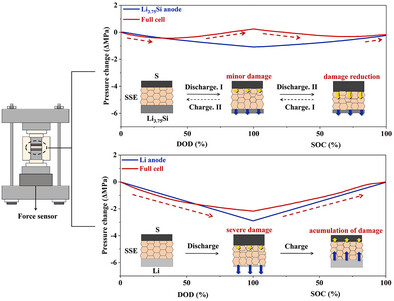预锂化硅基阳极全固态锂硫电池的交变应力演化及缓冲效应
IF 19
1区 材料科学
Q1 CHEMISTRY, MULTIDISCIPLINARY
引用次数: 0
摘要
硫化物基全固态锂硫电池(ASSLSBs)由于其高理论能量密度和增强的安全性,在下一代储能领域具有巨大的前景。然而,由于电极体积的大变化和机械应力引起的电解液开裂和界面损伤等疲劳问题仍然是关键的挑战。本文首先利用原位压力检测技术,分析了采用预锂化硅基阳极的ASSLSBs与传统锂金属的单调应力演化的不同选择。值得注意的是,预锂化硅基体系表现出交替应力优势模式,通过应力抵消效应有效地稳定了机械响应。此外,研究表明,预锂化硅基的应力缓冲效应源于锂化过程中中间体Li21Si5的相变动力学。采用有限元建模和微观结构形貌分析将相变动力学与机械应力调节直接联系起来。事实证明,这种独特的特性对于抑制电解质内的裂纹扩展,同时保持电极/电解质界面的稳定至关重要。因此,使用预锂化硅基的全电池在0.5C (~ 3.6 mA cm - 2)下具有高S负载(4.5 mg cm - 2)的稳定循环性能,优于传统的固态锂硫电池。发现的化学-机械耦合原理为开发高稳定性ASSLSBs提供了新的见解,特别是在减轻大体积变化引起的界面降解方面。本文章由计算机程序翻译,如有差异,请以英文原文为准。

The Alternating Stress Evolution and Buffering Effects in All‐Solid‐State Lithium–Sulfur Battery with Pre‐Lithiated Silicon‐Based Anode
Sulfide‐based all‐solid‐state lithium‐sulfur batteries (ASSLSBs) hold immense promise for next‐generation energy‐storage due to their high theoretical energy density and enhanced safety. However, fatigue issues such as electrolyte cracking and interfacial damage caused by big volume changes of both electrodes and mechanical stress remain critical challenges. Herein, the distinct alternative against monotonical stress evolution is first analyzed in ASSLSBs employing pre‐lithiated silicon‐based anodes versus conventional lithium metal by using in‐situ pressure‐detection techniques. Notably, the pre‐lithiated silicon‐based system demonstrates an alternating stress dominance pattern that effectively stabilizes mechanical responses through stress cancellation effects. Moreover, the investigation shows that the stress‐buffering effect of pre‐lithiated silicon‐based stems from the phase transition dynamics of intermediate Li21 Si5 during lithiation. The finite element modeling and micro‐structural morphology analysis is employed to link phase transformation kinetics directly to mechanical stress modulation. This unique characteristic proves crucial in suppressing crack propagation within electrolytes while maintaining stable electrode/electrolyte interfaces. Consequently, the full‐cell using pre‐lithiated silicon‐based achieves stable cycling performance with high S loading (4.5 mg cm−2 ) at 0.5C (∼3.6 mA cm−2 ), which outperforms conventional solid‐state lithium‐sulfur batteries. The discovered chemo‐mechanical coupling principles provide new insights for developing high‐stability ASSLSBs, particularly in mitigating interfacial degradation induced by large volume changes.
求助全文
通过发布文献求助,成功后即可免费获取论文全文。
去求助
来源期刊

Advanced Functional Materials
工程技术-材料科学:综合
CiteScore
29.50
自引率
4.20%
发文量
2086
审稿时长
2.1 months
期刊介绍:
Firmly established as a top-tier materials science journal, Advanced Functional Materials reports breakthrough research in all aspects of materials science, including nanotechnology, chemistry, physics, and biology every week.
Advanced Functional Materials is known for its rapid and fair peer review, quality content, and high impact, making it the first choice of the international materials science community.
 求助内容:
求助内容: 应助结果提醒方式:
应助结果提醒方式:


